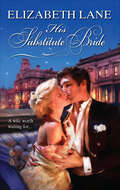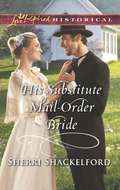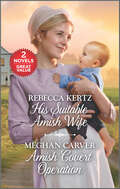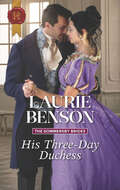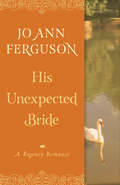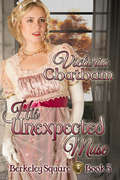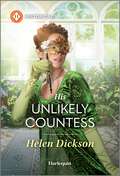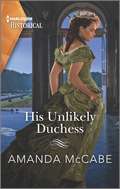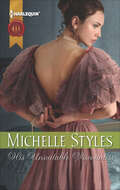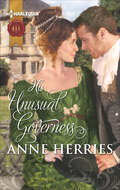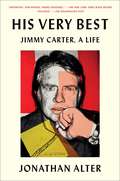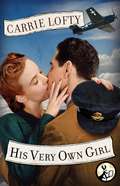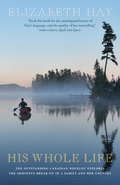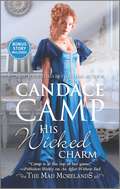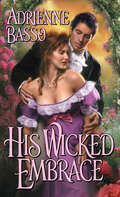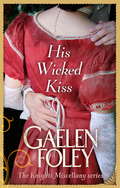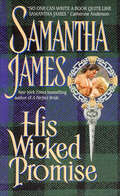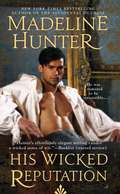- Table View
- List View
His Substitute Bride
by Elizabeth LaneDashing but cynical Quint Seavers lives for danger. A past betrayal has made him wary of love, and he has no idea that independent, practical Annie Gustavson holds a secret longtime passion for him. Nor does he realize that the only reason Annie has traveled to San Francisco is to win his love-or walk away forever.When disaster strikes the city, Annie's courage and determination match his own-and suddenly Quint knows that she is exactly what has been missing from his life all along....
His Substitute Mail-Order Bride: His Substitute Mail-order Bride Baby On Her Doorstep Accidental Sweetheart Last Chance Wife (Return to Cowboy Creek #2)
by Sherri ShackelfordStand-In WifeRuss Halloway’s mail-order bride never boarded the bride train! In her place is recently widowed Anna Darby Linford, sister of the last woman to jilt Russ. He’s surprised to see Anna again—and stunned when he discovers she’s pregnant. Marrying Anna seems the right thing to do...especially since love continues to evade him.Anna hopes Russ will help her find employment—becoming a wife again never even crossed her mind. Yet as she struggles to start over in the small town, Anna forges a genuine connection with Russ. When secrets from her past threaten Russ’s future in politics, can they protect their family in the making?
His Substitute Wife
by Dorothy ClarkA Convenient Marriage Blake Latherop needs a wife in order to keep his business, and his betrothed has apparently eloped with another man. So when his fiancée's sister, Audrey Prescott, steps off the train in Whisper Creek offering to be his bride, he's in no position to refuse. But it's hardly the marriage he had in mind. Audrey knows she shouldn't have answered Blake's letters in her sister's name...but she couldn't bring herself to tell him of his fiancée's betrayal. Now the only way to fix things is through a temporary marriage. But as she comes to love her new life in the West, Audrey dreads the day Blake finds another solution to their situation. Because what started as a marriage of convenience has become so much more for her...
His Suitable Amish Wife and Amish Covert Operation
by Rebecca Kertz Meghan CarverCan they put their trust in love?His Suitable Amish Wife by Rebecca KertzWhen Ellie Stoltzfus arrives to provide housecleaning and child-care services for her friend’s brother, Reuben Miller, the Amish widower is reluctant to agree. But, smitten with Reuben’s young son, Ellie is determined to see the job through. There’s no denying Ellie is good for both father and son, but still-grieving Reuben won’t marry for love again. Can he convince Ellie to be his wife…in name only?Amish Covert Operation by Meghan CarverAfter Amish widow Katie Schwartz’s search for her reclusive brother results in a shooting and her finding a cryptic message, she must rely on federal agent Adam Troyer to shield her. But, undercover as a Plain man, can Adam save her brother’s life and protect Katie? Trusting the handsome Englisch agent is already dangerous…but falling for him could risk everything Katie holds dear.
His Three-Day Duchess: A Duke In Need Of A Wife His Three-day Duchess Courting The Forbidden Debutante (The Sommersby Brides #3)
by Laurie BensonHe’s claimed his title. Could he inherit a bride, too? A romantic Regency adventure by a “very talented” author (Chicks, Rogues and Scandals).The Duchess of Skeffington retreats to the estate that was her refuge during her cruel marriage. She’s shocked to come face-to-face with the distant heir, now newly inherited duke, adventurous Simon Alexander.When Elizabeth is robbed, it’s up to them both to find the thief. But traveling together would attract too much gossip—unless they pose as husband and wife . . .
His Truth Is Marching On: John Lewis and the Power of Hope
by Jon MeachamAn intimate and revealing portrait of civil rights icon and longtime U.S. congressman John Lewis, linking his life to the painful quest for justice in America from the 1950s to the present—from the Pulitzer Prize–winning author of The Soul of America <P><P>John Lewis, who at age twenty-five marched in Selma, Alabama, and was beaten on the Edmund Pettus Bridge, was a visionary and a man of faith. Drawing on decades of wide-ranging interviews with Lewis, Jon Meacham writes of how this great-grandson of a slave and son of an Alabama tenant farmer was inspired by the Bible and his teachers in nonviolence, Reverend James Lawson and Martin Luther King, Jr., to put his life on the line in the service of what Abraham Lincoln called “the better angels of our nature.” <P><P>From an early age, Lewis learned that nonviolence was not only a tactic but a philosophy, a biblical imperative, and a transforming reality. At the age of four, Lewis, ambitious to become a minister, practiced by preaching to his family’s chickens. When his mother cooked one of the chickens, the boy refused to eat it—his first act, he wryly recalled, of nonviolent protest. Integral to Lewis’s commitment to bettering the nation was his faith in humanity and in God—and an unshakable belief in the power of hope. <P><P>Meacham calls Lewis “as important to the founding of a modern and multiethnic twentieth- and twenty-first-century America as Thomas Jefferson and James Madison and Samuel Adams were to the initial creation of the Republic itself in the eighteenth century.” A believer in the injunction that one should love one's neighbor as oneself, Lewis was arguably a saint in our time, risking limb and life to bear witness for the powerless in the face of the powerful. In many ways he brought a still-evolving nation closer to realizing its ideals, and his story offers inspiration and illumination for Americans today who are working for social and political change. <P><P><b>A New York Times Bestseller</b>
His Truth is Marching On: African Americans Who Taught the Freedmen for the American Missionary Association, 1861-1877 (Routledge Library Editions: Education 1800-1926 #4)
by Clara Merritt DeBoerThis title, first published in 1995, explores the history of the American Missionary Association (AMA) – an abolitionist group founded in New York in 1846, whose primary focus was to abolish slavery, to promote racial equality and Christian values and to educate African Americans. This title will be of interest to students of history and education.
His Unexpected Bride
by Jo Ann FergusonTess Masterson awakes to find handsome Cameron Hawksmoor in her bed. She is ruined! Who will wed her now? It doesn't matter, her father tells her, because she is already married. To Cameron. The son of a duke who was, before his death, Tess's father's good friend, Cameron wants to arrange for an annulment. But how is that possible when, still half-asleep himself, he just woke Tess with a kiss? This is madness, but only the beginning when they both know that the only way out is divorce, which will ruin Tess completely. As they learn more about each other, neither wants to hurt the other. Tess can see that Cameron fears his fierce temper so much that he tries to show no emotion, but that coolness is tested when a terrible accident leaves his brother's two young illegitimate sons in their care and makes Cameron a duke. Tess and Cameron must work together and learn to trust each other as other accidents happen. It becomes clear that they are not truly accidents. Who would want to kill two little boys? Or are they the real target? Tess and Cameron must uncover the truth if they have any hopes of saving the children and their own fragile love.
His Unexpected Muse (Berkeley Square Ser. #Vol. 3)
by Victoria ChathamWhen Lady Olivia Darnley is seemingly abandoned by her mother, she accepts the assistance of a stranger, Lady Skeffington, who offers her a position as a companion, much to her son’s dismay. Lord Peter Skeffington is not at all pleased that his mother has chosen to not only take Lady Olivia under her wing, but her dog, too. Despite his reservations, he finds in Olivia a shared interest in books and begins to look for her daily until he faces the uncomfortable realization that he is in love with her. Still hurt by her mother’s disappearance and desperate to find her, Olivia relies more and more on Peter’s support but a shocking betrayal by the man she has come to trust and love, shatters her new found happiness. Will Peter manage to overcome the rift between them that he has unwittingly caused? Will Olivia accept not only his apology but also his proposal of marriage? Is there a future for this apparently mismatched pair?
His Unexpected Wife (Mail-Order Bride)
by Maureen McKadeWith This Ring, I Thee Flee...High-spirited Annie Trevelyan leaves the mountains of Colorado behind, seeking fame and fortune, and no one is going to stop her. Not even Colin McBride, who's accompanying her West to make sure she goes to finishing school—and doesn't go astray! The lovely Annie's sure some timely flirtation will soon have Colin wrapped around her finger, but her coolly calculating kiss stokes unexpectedly passionate fires in them both. So now Annie must escape...because Colin's got marriage on his mind!In watching over Annie, Colin was just doing a favor for a friend. Now that he's tasted the sweetness of Annie's lips, though, Colin wants her for himself—and that means a wedding! He'd once thought only a prim, docile wife would do, but now visions of a fiery wedding night with this independent hellion fill his mind. The trouble will be convincing Annie—and holding on to her long enough to do so!
His Unlikely Countess
by Helen DicksonA lively Regency romance between a beautiful thief and a long-lost earl…whose hidden identities threaten to unleash a scandal! They sought retribution… And found temptation! Left penniless by her father&’s untimely death, Joanna Somerville sets out to steal back the emerald necklace he gambled away—but she&’s not the only masquerading highwayman intending to rob the coach that night… William, the long-lost Earl of Evesham, has also returned to reclaim a family heirloom and his birthright from his scheming stepbrother. United against their common enemy, William matches wits with the bold and captivating Joanna. But he never expects their connection to go beyond revenge…and lead to a scandalous affair with a most unlikely countess! From Harlequin Historical: Your romantic escape to the past.
His Unlikely Duchess (Dollar Duchesses #1)
by Amanda McCabeMoney can buy her marriageBut will it lead to love?Miss Lily Wilkins hopes her American money will compensate for her lack of etiquette, as she needs a prestigious marriage to save her sisters’ prospects. Raised to believe wealth was her greatest attribute, she’s stunned when her unconventional ways catch the eye of the notorious Duke of Lennox. He’s far from the safe, sensible match she’d planned on—but Lily might just discover he’s the one she needs! From Harlequin Historical: Your romantic escape to the past.Dollar DuchessesMoney for Marriage into London SocietyBook 1: His Unlikely Duchess
His Unsuitable Viscountess
by Michelle StylesA lifetime of living in a man's world has given sword-making-factory owner Eleanor Blackwell some very definite opinions-particularly about the duplicity of men!Benjamin Grayson, Viscount Whittonstall, seems to be cut from a different cloth-Eleanor responds to his touch with a passion normally reserved only for fencing! She may be spectacularly unsuited to mix with aristocracy, but Ben has different ideas when he plans to safeguard her business with a very convenient proposal....
His Unusual Governess
by Anne HerriesBeneath the governess's blush...Heiress Sarah Hardcastle is convinced her plan to escape the unwanted attentions of a fortune hunter is foolproof. Buried deep in the countryside, and with a whole new identity as prim governess Miss Goodrum, Sarah is looking forward to the quiet life for once.But her careful masquerade is shaken when she meets her pupils' mentor, Lord Rupert Myers. An incorrigible flirt, Rupert has the looks and the charm to make Sarah blush all the way down to her high-buttoned neckline-and the determination to uncover what's beneath! Sarah will need her wits about her if she's to resist Rupert's roguish ways and keep her secret intact....
His Very Best: Jimmy Carter, a Life
by Jonathan AlterFrom one of America&’s most-respected journalists and modern historians comes the first full-length biography of Jimmy Carter, the thirty-ninth president of the United States and Nobel Prize–winning humanitarian. Jonathan Alter tells the epic story of an enigmatic man of faith and his improbable journey from barefoot boy to global icon. Alter paints an intimate and surprising portrait of the only president since Thomas Jefferson who can fairly be called a Renaissance Man, a complex figure—ridiculed and later revered—with a piercing intelligence, prickly intensity, and biting wit beneath the patented smile. Here is a moral exemplar for our times, a flawed but underrated president of decency and vision who was committed to telling the truth to the American people. Growing up in one of the meanest counties in the Jim Crow South, Carter is the only American president who essentially lived in three centuries: his early life on the farm in the 1920s without electricity or running water might as well have been in the nineteenth; his presidency put him at the center of major events in the twentieth; and his efforts on conflict resolution and global health set him on the cutting edge of the challenges of the twenty-first. Drawing on fresh archival material and five years of extensive access to Carter and his entire family, Alter traces how he evolved from a timid, bookish child—raised mostly by a black woman farmhand—into an ambitious naval nuclear engineer writing passionate, never-before-published love letters from sea to his wife and full partner, Rosalynn; a peanut farmer and civic leader whose guilt over staying silent during the civil rights movement and not confronting the white terrorism around him helped power his quest for racial justice at home and abroad; an obscure, born-again governor whose brilliant 1976 campaign demolished the racist wing of the Democratic Party and took him from zero percent to the presidency; a stubborn outsider who failed politically amid the bad economy of the 1970s and the seizure of American hostages in Iran but succeeded in engineering peace between Israel and Egypt, amassing a historic environmental record, moving the government from tokenism to diversity, setting a new global standard for human rights, and normalizing relations with China among other unheralded and far-sighted achievements. After leaving office, Carter eradicated diseases, built houses for the poor, and taught Sunday school into his mid-nineties. This engrossing, monumental biography will change our understanding of perhaps the most misunderstood president in American history.
His Very Own Girl
by Carrie LoftyFrom the author of Flawless and Starlight comes an emotional, sensual romance set during World War II about a female British civilian pilot and the American paratrooper medic who opens her heart--only available as an eBook.After the War took the lives of Lulu Davies's parents and her fiancé, she promised herself she would guard her heart carefully and concentrate on her great love--flying the biggest and best airplanes in the sky. Lulu is a pilot in the British civilian air force, ferrying planes around Great Britain and keeping her eye on a coveted spot in a training program for world-class pilots. She's perfectly content to strive for greatness in the skies, and dance with a few GIs on the way. Brawny, quiet American medic Joe Weber signed up with the paratroopers to escape his checkered past; he's hoping that jumping out of planes and patching up soldiers will earn him respect and a hopeful future. Joe's first real test of medical skill is on a pilot whose plane takes a hard landing in a training field; after rushing to the crash scene, he is stunned to come face-to-face with a gorgeous Rita Hayworth lookalike. And when the two cross paths at a dance hall a couple weeks later, he can't resist the urge to find out more about this spirited, dark-haired beauty.Their flirtation breaks all of Lulu's rules, but dance by dance, week by week, walk by walk, she finds herself falling in love with this honest, vulnerable man on the run from his demons. But as Lulu and Joe's undeniable attraction gains momentum, World War II steadily intensifies toward D-Day. The lovers only have one night together before Joe is transported to France for the Battle of the Bulge, where his skills and his instinct for survival will be pushed to their limits. Lulu distracts herself with flight school and the friendships of her colleagues, but she can't get the handsome medic out of her head. Only time and hope will tell if her love will return unharmed from War, and if the two will be able to overcome their pasts to form a beautiful life together in peace-time.
His Whole Life
by Elizabeth HayStarting with something as simple as a boy who wants a dog, His Whole Life takes us into a richly intimate world where everything that matters to him is at risk: family, nature, home.At the outset ten-year-old Jim and his Canadian mother and American father are on a journey from New York City to a lake in eastern Ontario during the last hot days of August. What unfolds is a completely enveloping story that spans a few pivotal years of his youth. Moving from city to country, summer to winter, wellbeing to illness, the novel charts the deepening bond between mother and son even as the family comes apart.Set in the mid-1990s, when Quebec is on the verge of leaving Canada, this captivating novel is an unconventional coming of age story as only Elizabeth Hay could tell it. It draws readers in with its warmth, wisdom, its vivid sense of place, its searching honesty, and nuanced portrait of the lives of one family and those closest to it. Hay explores the mystery of how members of a family can hurt each other so deeply, and remember those hurts in such detail, yet find openings that shock them with love and forgiveness. This is vintage Elizabeth Hay at the height of her powers.
His Whole Life
by Elizabeth HayStarting with something as simple as a boy who wants a dog, His Whole Life takes us into a richly intimate world where everything that matters to him is at risk: family, nature, home.At the outset ten-year-old Jim and his Canadian mother and American father are on a journey from New York City to a lake in eastern Ontario during the last hot days of August. What unfolds is a completely enveloping story that spans a few pivotal years of his youth. Moving from city to country, summer to winter, wellbeing to illness, the novel charts the deepening bond between mother and son even as the family comes apart.Set in the mid-1990s, when Quebec is on the verge of leaving Canada, this captivating novel is an unconventional coming of age story as only Elizabeth Hay could tell it. It draws readers in with its warmth, wisdom, its vivid sense of place, its searching honesty, and nuanced portrait of the lives of one family and those closest to it. Hay explores the mystery of how members of a family can hurt each other so deeply, and remember those hurts in such detail, yet find openings that shock them with love and forgiveness. This is vintage Elizabeth Hay at the height of her powers.
His Wicked Charm: A Historical Romance (The\mad Morelands Ser. #6)
by Candace CampShe’s too primLilah Holcutt dislikes Constantine Moreland from the moment she meets him. He may be handsome, but he’s frivolous, rash, impulsive and, worst of all, a flirt. Now that Con’s twin brother has married Lilah’s best friend, she’s seeing way more of Con than she’d like. And when Con’s sisters are inexplicably kidnapped, Lilah’s own curiosity and stubbornness get the better of her, and she finds herself swept into Con’s investigation. He’s indifferent to proprietyCon knows that Lilah hates him—he just wishes she weren’t so devastatingly beautiful, that he weren’t so attracted to her. Especially since they’re working closely together to solve the kidnapping, an adventure that leads them to Lilah’s peculiar childhood home, Barrow House, which sits atop an ancient fen and features an eerie maze on its grounds.They’ll have to join together to conquer a sinister forceThe more Con and Lilah uncover, the more they’re convinced that the answers lie buried deep within Barrow House—answers to a mystery darker than either of them could ever have realized.
His Wicked Christmas Wager
by Annie BurrowsThe last person Lord Crispin Sinclair expects to see in a disreputable inn is the woman he's there to forget: Lady Caroline Fallowfield. He hasn't forgiven her for marrying another man-or forgotten their mutual passion. When she implores him to come home for his brother's Christmas nuptials, he agrees-if the now-widowed Caroline is willing to share his bed and take another gamble on love...
His Wicked Embrace
by Adrienne BassoA dashing widower yearns for his new governess, but his secret could ruin everything in this Regency romance by the author of Intimate Betrayal.ONE KISS IS ALL IT TAKESDamien St. Lawrence, the eighth Earl of Sanders, couldn&’t believe his eyes. Though the woman standing before him bore a striking resemblance to his late wife, it was her familiar violet eyes that haunted him . . . while stirring his senses to an irresistible longing.FOR A LADY OF VIRTUEMiss Isabella Browning was both frightened and intrigued by her new employer. Rumors and scandalous tales about him were rife, but Isabella was drawn to Damien&’s tender concern for his children—and the temptation of his arms around her.TO BECOME A MISTRESS OF DESIRE Ignoring her escalating passion for Damien, Isabella threw herself into her work, trying to keep her two unruly charges out of mischief. Yet with each passing day, Isabella found herself succumbing to Damien&’s spell. But just as her trust grew, Lord Thomas Poole, Damien&’s brother-in-law arrived, determined to make Isabella his by exposing Damien&’s dark secrets. Soon the shocking truth about Damien&’s wife was revealed—a truth that could destroy their love, or prove that it could overcome anything. . . .&“This story comes to life with its vibrant setting descriptions, full-bodied characters and all engrossing plot. Adrienne Basso intricately weaves a mystical tale of intrigue and romance. His Wicked Embrace will capture your heart and leave you longing for more!&” —Literary Times
His Wicked Kiss
by Gaelen FoleyFor the last few years Eden Farraday has been aiding her father who is obsessed with finding a cure for the fever that killed her mother in the wild jungles of South America. Nearly twenty-two years old, Eden longs to return to the society of London where she can find a husband and lead a normal life. When a strange ship moors at their settlement on the Orinoco river, Eden feels fate beckoning. . . Dynamic but dangerous Lord Jack Knight is a self-made, wealth-obsessed shipping tycoon with a shadowy past and a reputation for ruthlessness. Relieved to come upon the settlement of his old friend, Dr. Victor Farraday, Lord Knight takes a night's rest, takes note of the doctor's beautiful daughter, and sets sail the next morning for his long journey back to England. However, when his crew uncovers a stowaway on board, he is stunned to find the culprit is none other than Eden Farraday. Too far in his journey to return Eden to her father, the furious Knight agrees to take Eden as far as London. Upon their arrival, they part company, each continuing to fight the magnetic pull they feel toward one another. . .
His Wicked Kiss: Number 7 in series (Knight Miscellany #7)
by Gaelen FoleyFor the last few years Eden Farraday has been aiding her father who is obsessed with finding a cure for the fever that killed her mother in the wild jungles of South America. Nearly twenty-two years old, Eden longs to return to the society of London where she can find a husband and lead a normal life. When a strange ship moors at their settlement on the Orinoco river, Eden feels fate beckoning. Dynamic but dangerous Lord Jack Knight is a wealth-obsessed self-made man with a shadowy past and a reputation for ruthlessness. Relieved to come upon the settlement of his old friend, Dr. Victor Farraday, Lord Knight takes a night's rest, takes note of the doctor's beautiful daughter, and sets sail the next morning for his long journey back to England. However, when his crew uncovers a stowaway on board, he is stunned to find the culprit is none other than Eden Farraday. Too far in his journey to return Eden to her father, the furious Knight agrees to take Eden as far as London. Upon their arrival, they part company, each continuing to fight the magnetic pull they feel toward one another
His Wicked Promise
by Samantha JamesA young widow’s marriage to a Highland warrior unleashes a long-hidden passion in the New York Times–bestselling author’s medieval Scottish romance.When Egan MacBain takes beautiful Glenda MacKay as his bride, it appears that he's done so for the noblest of reasons. In truth, he has vowed at last to claim the woman he's always loved—yet once lost—to another man. The rugged Highlander is determined to keep his passion hidden, for he will only show his tenderness once she is tamed.Glenda agreed to marry Egan for the protection of his name. The young widow never expected that vows of love would leave her lips again, nor did she believe she'd ever hold any man so dear. But now she finds herself succumbing to the strong, silent warrior who fills her with a forbidden yearning for the love—and the child—that he so wickedly promised.
His Wicked Reputation (Wicked Trilogy #1)
by Madeline HunterFrom the New York Times bestselling Madeline Hunter comes this first in a stunning new trilogy about three irresistibly attractive brothers. This is the story of the bastard brother.... For fans of Mary Balogh and Amanda Quick. Gareth Fitzallen is celebrated for four things: his handsome face, his notable charm, his aristocratic connections, and an ability to give the kind of pleasure that has women begging for more. Normally he bestows his talents on experienced, worldly women. But when he heads to Langdon's End to restore a property he inherited--and to investigate a massive art theft--he lays plans to seduce a most unlikely lady. Eva Russell lives a spinster's life of precarious finances and limited dreams while clinging to her family's old gentry status. She supports herself by copying paintings while she plots to marry her lovely sister to a well-established man. Everyone warns her of Gareth's reputation, and advises her to lock her sister away. Only it is not her sister Gareth desires. One look, and she knows he is trouble. One kiss, however, proves she is no match for this master of seduction.From the Paperback edition.
